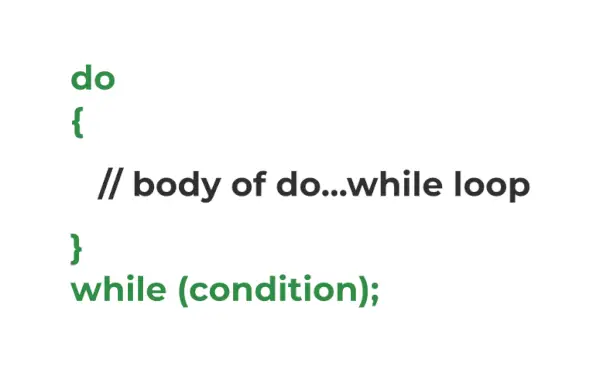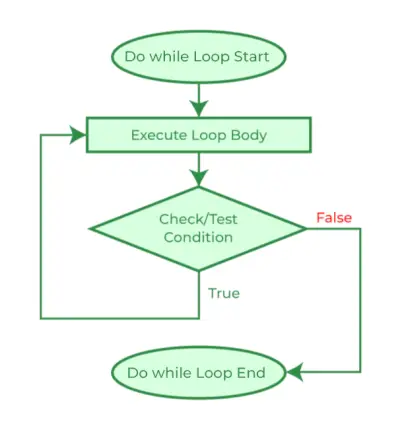Los bucles en lenguaje C son declaraciones de flujo de control que se utilizan para repetir alguna parte del código hasta que se cumpla la condición dada. El bucle hacer-mientras es una de las tres sentencias de bucle en C, las otras son el bucle while y el bucle for. Se utiliza principalmente para atravesar matrices, vectores y otras estructuras de datos.
¿Qué es hacer...mientras bucle en C?
El hacer... mientras estás en C es una declaración de bucle que se utiliza para repetir alguna parte del código hasta que se cumpla la condición dada. Es una forma de un bucle de salida controlada o post-probado donde se verifica la condición de prueba después de ejecutar el cuerpo del bucle. Debido a esto, las declaraciones en el bucle do... while siempre se ejecutarán al menos una vez, sin importar cuál sea la condición.
Sintaxis de do… while Loop en C
do { // body of do-while loop } while ( condition );> Cómo utilizar el bucle do... while en C
El siguiente ejemplo demuestra el uso del bucle do... while en el lenguaje de programación C.
C
// C Program to demonstrate the use of do...while loop> #include> int> main()> {> >// loop variable declaration and initialization> >int> i = 0;> >// do while loop> >do> {> >printf>(>'Geeks
'>);> >i++;> >}>while> (i <3);> >return> 0;> }> |
>
>Producción
Geeks Geeks Geeks>
¿Cómo funciona el bucle do... while?

Estructura de sintaxis del bucle do while
El funcionamiento del bucle do... while se explica a continuación:
- Cuando el control del programa llega por primera vez al bucle do... while, el cuerpo del bucle se ejecuta primero y luego se verifica la condición/expresión de prueba , a diferencia de otros bucles donde primero se verifica la condición de prueba. Debido a esta propiedad, el bucle do... while también se denomina bucle de salida controlada o bucle de prueba posterior.
- Cuando la condición de prueba se evalúa como verdadero , el El control del programa va al inicio. del bucle y el cuerpo se ejecuta una vez más.
- El proceso anterior se repite hasta que la condición de prueba sea verdadera.
- Cuando la condición de prueba se evalúa como FALSO, los controles del programa pasan a las siguientes declaraciones después del bucle do… while.
Al igual que con el bucle while en C, la inicialización y actualización no son parte de la sintaxis del bucle do... while. Tenemos que hacerlo explícitamente antes y en el ciclo respectivamente.
El siguiente diagrama de flujo muestra la representación visual del flujo del bucle do... while en C.
C hacer...mientras diagrama de flujo de bucle

Diagrama de flujo de do... while Loop en C
Anidado do... while Loop en C
Al igual que con otros bucles, también podemos anidar un bucle do... while en otro bucle. Se demuestra utilizando el siguiente programa en C.
Ejemplo de bucle anidado do... while en C:
C
// C Program to demonstrate the nesting of do...while loop> #include> int> main()> {> >// declaring loop variables> >int> i = 0, j;> >int> count = 0;> >// outer loop starts> >do> {> >j = 0;> >// inner loop starts> >do> {> >printf>(>'%d '>, count++);> >j++;> >}>while> (j <3);> >// inner loop ends> >printf>(>'
'>);> >i++;> >}>while> (i <3);> >// outer loop ends> >return> 0;> }> |
>
>Producción
0 1 2 3 4 5 6 7 8>
Para saber más sobre los bucles anidados en C, consulte este artículo: Bucles anidados en C con ejemplos
Ejemplos de bucle do... while en C
Ejemplo 1. Programa C para demostrar el comportamiento del bucle do… while si la condición es falsa desde el principio.
C
cómo desactivar el modo desarrollador de Android
// C Program to demonstrate the do...while loop behaviour> // when the condition is false from the start> #include> #include> int> main()> {> >// declaring a false variable> >bool> condition =>false>;> >do> {> >printf>(>'This is loop body.'>);> >}>while> (condition);>// false condition> >return> 0;> }> |
>
>Producción
This is loop body.>
Como podemos ver, incluso cuando la condición es falsa al inicio, el cuerpo del bucle se ejecuta una vez. Esto se debe a que en el bucle do... while, la condición se verifica después de pasar por el cuerpo, por lo que cuando el control está al inicio,
- Pasa por el cuerpo del bucle.
- Ejecuta todas las declaraciones del cuerpo.
- Comprueba la condición que resulta ser falsa.
- Luego sale del bucle.
Ejemplo 2. Programa C para imprimir la tabla de multiplicar de N usando el bucle do… while
El siguiente ejemplo demuestra el uso del bucle do... while para imprimir la tabla de multiplicar de N.
C
// C Program to print multiplication table using do...while> // loop> #include> int> main()> {> >int> N = 5, i = 1;> >do> {> >printf>(>'%d x %d = %d
'>, N, i, N * i);> >}>while> (i++ <10);> >return> 0;> }> |
>
menú de configuración del teléfono Android
>Producción
5 x 1 = 5 5 x 2 = 10 5 x 3 = 15 5 x 4 = 20 5 x 5 = 25 5 x 6 = 30 5 x 7 = 35 5 x 8 = 40 5 x 9 = 45 5 x 10 = 50>
Diferencia entre while y do… while Loop en C
La siguiente tabla enumera los importantes diferencias entre el while y el do… while Loop Cª.
| mientras bucle | hacer...mientras bucle |
|---|---|
| Se verifica la condición de prueba. antes de que se ejecute el cuerpo del bucle. | Se verifica la condición de prueba. después de ejecutar el cuerpo. |
| Cuando la condición es falsa, el el cuerpo no se ejecuta ni una sola vez. | El cuerpo del hacer...mientras el bucle se ejecuta al menos una vez incluso cuando la condición es falsa. |
| Es un tipo de bucle previamente probado o controlado por entrada. | Es un tipo de bucle post-probado o de salida controlada. |
| No se requiere punto y coma. | Se requiere punto y coma al final. |
Para saber más sobre estas diferencias, consulte este artículo: Diferencia entre bucle while y do- while en C, C++, Java
Conclusión
En conclusión, el uso del único bucle controlado por salida en C, el bucle do... while también sirve para iterar una parte particular del código, pero la forma en que funciona lo diferencia de los bucles controlados por entrada, como el bucle while y el bucle for. bucle. Es útil en los casos en los que necesitamos ejecutar la declaración dentro del cuerpo del bucle al menos una vez, como al atravesar listas circulares enlazadas.
Preguntas frecuentes sobre C do... while Loops
1. ¿Cuántos tipos de bucles hay en C?
Años: Hay 3 tipos de bucles en lenguaje C:
- en bucle
- mientras bucle
- hacer...mientras bucle
2. ¿Qué son los bucles de entrada controlada o probados previamente?
Años: Los bucles de entrada controlada o bucles previamente probados son aquellos bucles en los que el bucle La condición se verifica antes de ejecutar el cuerpo. del bucle.
3. ¿Qué son los bucles de salida controlada o posprobados?
Años: Los bucles de salida controlada o bucles post probados son aquellos bucles en los que El control del programa llega al cuerpo del bucle antes de comprobar la condición del mismo. .
4. ¿Qué bucle se garantiza que se ejecutará al menos una vez?
Años: El hacer...mientras bucle Se garantiza que ejecutará las declaraciones en el cuerpo del bucle al menos una vez, ya que es un tipo de bucle controlado por salida.
5. ¿Podemos omitir las llaves en C do… while sintaxis del bucle si solo hay una declaración en el cuerpo?
Ans: No , no podemos omitir las llaves en la sintaxis do... while de C incluso si solo hay una declaración, a diferencia de los bucles while y for.
6. ¿Cómo crear un bucle infinito en C usando el bucle do… while?
Años: Podemos crear un bucle infinito en C especificando un condición que siempre será cierta como condición del bucle. El siguiente programa demuestra cómo hacerlo:
C
// C Program to create a infinite loop using do...while loop> // in C> #include> int> main()> {> >// infinite loop> >do> {> >printf>(>'gfg '>);> >}>while> (1);>// always 1 ~ true> >return> 0;> }> |
>
>
Producción
gfg gfg gfg gfg gfg gfg gfg .... (infinite)>
